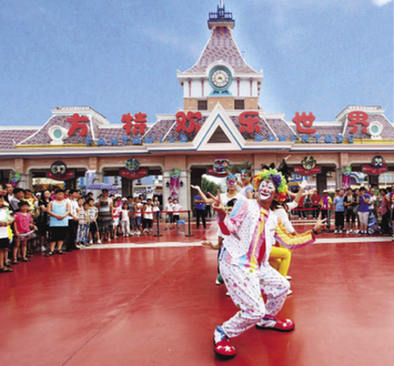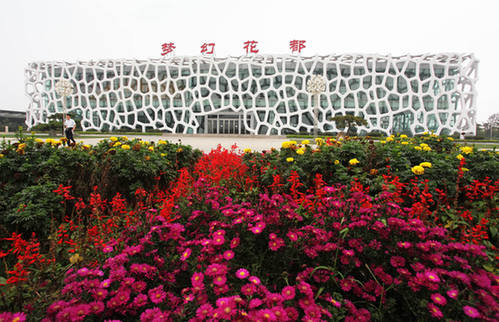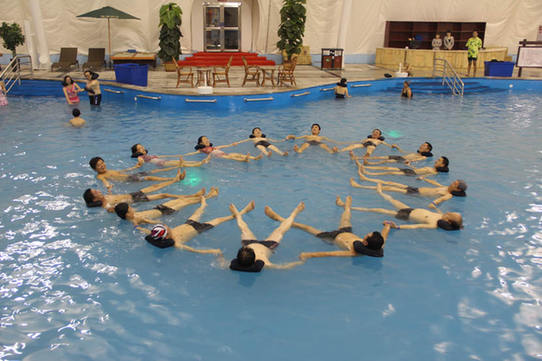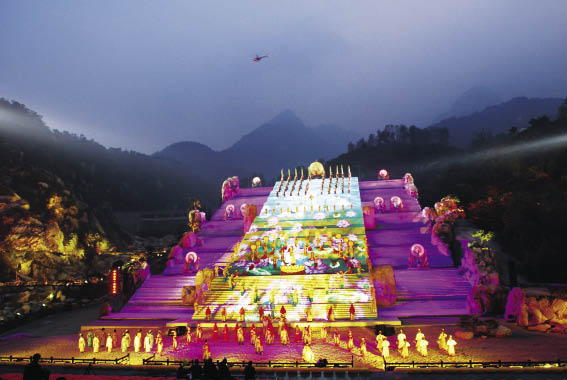The Eternal Couple Taishan Mountain and Tai’an City
By WU MEILING & LI ZHUOXI
TAI’AN City is located in the center of Shandong Province, home to the ancient states of Lu and Qi. Built in homage to Taishan Mountain (Mount Tai), one of China’s sacred peaks, the city was named after an old saying: “If all is well on Taishan Mountain, the world will be at peace.” “Tai’an” literally means “peace upon Taishan.”
The mountain is a stone’s throw away from the city, making it a hub for visitors and pilgrims. Throughout its history emperors, generals, men of letters and common folk alike have come here to savor the grand scenery, pray in tranquil surrounds and write poetry.
In the Chinese tradition, Taishan is more than a mere mountain. It is the sum of spiritual beliefs of a people, and the grand totem of a nation.
While the mountain demands the attention of visitors to Tai’an, the 2,000-year-old city is a marvel in itself.
Tai’an is one of several locales regarded as a birthplace of ancient Chinese civilization. As early as 5,000 years ago, the region was home to advanced human settlements. Evidence attests to the growth of the Dawenkou Culture here during the period when Chinese society transformed from matriarchy to patriarchy.
The old government building, operational for 1,000 years from the Song (960-1276) to the Qing (1644-1911) dynasties, is still a city landmark. The old doors creak when pushed open, while the blue stone walls and statues inside remind visitors of time-honored legends.
Touring Taishan Mountain
In China, Taishan is said to be the nation’s No.1 mountain, and is one of its five sacred peaks. It is not tall – standing on top, visitors are only 1,545 meters above sea level, but its history and scenery make it a giant.
 |
| Fantawild, Tai'an's very own adventure parkl. Jiang Weichang |
Standing on the North China Plain, the mountain overlooks the sea to the east and the Yellow River to the west, which appears like a golden ribbon winding beyond undulating hills. For Chinese in the region, Taishan appears as a pillar supporting the sky.
When discussing Taishan’s history, the importance attached to it by successive emperors is a good place to start.
Even before Emperor Qinshihuang unified China in 221 BC, there were 72 attested kings of states who scaled the peak for various reasons. For ancient Chinese, Taishan, standing in the east of the country, ushered in the sun’s first light every day.
Many of the kings held sacrificial ceremonies on the peak, with the aim of getting closer to God. However, not every emperor had the right to perform the fengshan, a solemn ritual ceremony regarded as a reward for particular feats. Fengshan would only be held when emperors united the country or maintained peace despite the odds. Fengshan was thus a symbol of peace and prosperity. According to official histories, only 12 emperors conducted the sacred ceremony.
The mountain blessed emperors as well as the common people. Scaling Taishan would ensure peace in one’s household and beyond. Chinese people today continue to believe this – it has become a faith of sorts in its own right, and thousands of visitors climb the peak every day of the year.
The mountain has been the spiritual home of the nation for as long as people can remember. As early as the Neolithic period, the mountain has been a natural refuge for human populations. The people of the Dawenkou Culture are understood to have prayed for rain on Taishan. When the Yellow River, the “Mother River” of China, flooded, people would seek safety by climbing the peak. One piece of ancient pottery unearthed on a slope depicts the sun above, flames in the middle and Taishan below. This indicates the belief that Taishan lit the sun. It is not hard to see why the mountain would thus be worshipped.
Time flies, and gods change. Nowadays people climb Taishan to worship Lord Dongyue and the “Grandma Taishan. Dongyue is another name for Taishan, meaning “sacred mountain in the east.” Why is it sacred? The legend goes that Pangu, the progenitor of all human beings, created the world by seperating the heaven from the earth with his axe. When he died, his head became Taishan Mountain. “Grandma Taishan” is a nickname for the Bixia Goddess, who was sent by the Yellow Emperor to the mountain to take care of its people. Today, Bixia Temple is still the most popular place for praying on the mountain.
 |
| Taishan Colorful Times, a combination of movie town and tourist resort. |
Climbing Taishan affords a window on traditional Chinese culture. One passes a myriad of stone inscriptions en route that present different stages and schools of Chinese calligraphic art, from the earliest carved in the Qin Dynasty (221-206 BC), to 2,200 later inscriptions written by emperors. If visitors have a particular interest in Chinese painting and calligraphy, the Taishan Galley in Tai’an City is also a good place to deepen one’s knowledge of the disciplines. The gallery focuses on Taishan Mountain as depicted in art, and its collection is second to none.
Poems relating to Taishan represent some of the grandest examples of Chinese poetic achievement. Experts estimate that roughly 16,000 historical poems were composed on the mountaintop. Many of these are still known today; some have even made the transition into proverbs.
Confucius (551–479 BC) once said that standing on Taishan, one will find out how small the world actually is. China’s great historian Sima Qian (145–87 BC) wrote in his Records of the Historian, “Though death befalls all men alike, it may be weightier than Mount Tai or lighter than a feather.” Two of the country’s greatest poets, Li Bai (701–762) and Du Fu (712–770), also composed poems while climbing the mountains. Li waxed that, “calling out at Tianmen Gate, the wind comes in from a thousand miles away.” Du wrote: “Some day when I reach the top, all peaks in view will be dwarfed.”
Taishan is the incarnation of 5,000 years of Chinese culture. But today the mountain still finds a place in modernity. Since the First International Climbing Festival was held there in 1987, Taishan has played host to sports and cultural carnivals, theatrical performances and even trade talks. Tourists continue to ascend its famed slopes, injecting vitality into the old colossus.
“What shall I say of the Great Peak?
The ancient dukedoms are everywhere green,
Inspired and stirred by the breath of creation,
With the Twin Forces balancing day and night.”
These are the first four lines of Du Fu’s A View of Taishan. On arrival at the mountain, travelers, just like Du Fu, are sure to be in awe of the majesty of the scenery and the grandness of the peak in front of them.
On the south slope, there are three geographic faults – the Yunbuqiao Fault, the Zhongtianmen Fault, and the Tai-qian Fault. They rise like steps, forming three distinct, sharply contrasting landscapes. Zhongtianmen, literally “Half-way Gate to Heaven,” rises to 700 meters over Tai’an City. The mountain peak, Yuhuangding, is 700 meters higher than Zhongtianmen. The stretch between the bottom of the Songshan Valley and Nantianmen, or South Gate to Heaven, is 400 meters in vertical height. The section is the most challenging for hikers, who face 1,600 steps and 18 bends.
From the foot of the mountain to the Half-way Gate to Heaven, the slope is quite gentle and is lush with dense forests of pine trees. Arriving at the Gate, the slope rises and the path becomes narrow and winding. Hikers start puffing, but no one, not even those in their 70s, gives up with the peak in sight. As the saying goes, “The most beautiful scenery is saved for the perilous peak.”
From the mountaintop, the view is spectacular no matter which way one looks. But four sights stand above all others: sunrise, the golden ribbon of the Yellow River, the sea of clouds (best viewed on an overcast day), and the dull glow of sunset. Climbers time their arrival at the peak to fit in with one of these spectacular phenomena.
Sunrise is arguably the best time to survey the surrounding countryside. If you time your ascent up the 7,000 steps to perfection, you can arrive at the peak just as the sun is edging up over the horizon. The stars gradually disappear as the heavens fill with pale light. Soon, the brilliant yellow of the new dawn is upon you, and the mountain, veiled in darkness on your ascent, reveals itself beneath your feet. If you’re lucky, you’ll be standing above a sea of clouds from your vantage point atop a mountain-island. It is simply marvelous.
Tai’an’s Leisure Scene
Tai’an, south of the fabled mountain and north of Wenshui River, is a tourist destination in its own right. Its auspicious geographic location between a mountain and a river is deemed by ancient Chinese medicinal precepts to connect the essence of heaven and earth.
There are many health spas and natural springs in the city. Visitors take their pick. In the evenings local culture is on full display at shadow puppet shows, musical performances and cabaret-type theaters.
In Taishan Colorful Times, a combination of movie town and tourist resort, visitors can see flowers bloom in spring, take a dip in any number of lakes in summer, pick fruits in time for the autumn harvest and marvel at virgin snow in winter. Tourists jostle with locals for that perfect photo opportunity in the scenic area. At certain times of year happy brides and grooms descend on the area’s Tianhe Garden for pre-wedding photo shoots. The site recently launched a new tourism program – ethnic musical performances.
 |
| The Tianlecheng water park. Li Ming |
There are also activities for children in Tai’an. Fantawild is Tai’an’s very own adventure park. It features Disney-esque castles, roller coasters and Ferris Wheels. At the center of a park is a lovely lake, which makes a great spot for parents to relax while the children tire themselves out on the rides.
Another attraction in the city for adults and children alike is Tianlecheng, an indoor water park. It features a white beach with sand imported from Phuket, Thailand. The park is the largest of its kind in Asia. There is also a salt-water river in the complex; revelers float just as they would do in salt-water bodies such as the Dead Sea.
Hot springs make for a relaxing way to spend a day, and also carry medicinal benefits. Tai’an’s favorite is called simply “Tai’an Hot Spring”; it’s a natural formation and has high mineral content. You’ll come away from a visit feeling – and looking – great.
The holiday-making resort Baotailong opened its doors last June. The site sits upon an underground river. Rubber tubes are on hire; float down the river at your own leisure. Also within the resort complex is a bird-watching island, a man-made wetlands zone, the Wanshou Peak and a cultural park. A few days in Baotailong is a few days well spent.
Cultural Tourism
Off the southern flank of the Tai’an section of Beijing-Shanghai Railway stands a modernistic building. It is the Tai’an Art and Culture Center. On its grounds are the city library, an art museum, a gallery and a theater. It serves as an all-encompassing platform for cultural exchange, teaching and performance.
The film town in Dongping County is themed on Outlaws of the Marsh, one of the four Chinese classic novels written in the 14th century. The town’s buildings are all in the construction style of the Song Dynasty and appear in period-piece films every year. Visitors are free to don Song costumes and wonder around when there’s a lull in filming. At noon time, there’s a range of restaurants open to the public, where you can feast on meat and liquor, just as the heroes in Outlaws of the Marsh were fond of doing. After lunch you can take a boat ride on Dongping Lake. Your last stop should be the fortress on Liugong Mountain, a site mentioned in the novel.
There is also a culture and tourism plaza in Tai’an, which is home to first-tier Chinese culture brands such as the Liu Laogen Theater from northeastern China, the Pan Xiaoting Billard Club, Julecun Restaurant and Laoshe Teahouse. Visitors can get to know local folk arts that have been listed as national intangible cultural heritages, such as the Taishan shadow play, colored glazed wares from Zibo City, papercuts from Gaomi City, New Year woodblock prints from Yangjiabu Village, kites from Weifang City, clay dolls from Huimin County and Shandong-style embroidery. The cultural items and artworks are not simply displayed and sold. Visitors get a chance to see how they are made and can even have a go at making their own pieces.
Traveling in Tai’an is not complete without making forays into the local cuisine. Famous local dishes include the Taishan Mountain Tofu Banquet, which features over 100 different tofu dishes; Chilin (red scale) Fish, a kind of freshwater fish indigenous to Taishan Mountain springs; Taishan Mountain green tea, and locals’ favorite items — baked donkey oil cake and Taishan thin pancakes.
Another activity visitors can’t afford to miss in Tai’an is the Fengshan Ceremony, which today takes the form of a large-scale live-action performance. The ceremony is performed every evening on Tianzhu Peak of the eastern section of Taishan Mountain. The performance was choreographed by Mei Shuaiyuan, founder of China’s large-scale landscape live-action performance art.
 |
| A live-action performance of the Fengshan Ceremony on Tianzhu Peak. Wang Dequan |
At eight o’clock in the evening, visitors take their seats in the outdoor theater, spectacularly set under Tianzhu Peak. In front of them stands the stage with the mountain scenery as a backdrop. The stars begin to reveal themselves just as the performance gets underway; the whistling of the wind through the pine trees below adds to the drama. The performance lasts 80 minutes and features 500 actors, all of whom change costumes 10 times during the show. The interaction between light and sound makes for a splendid ambience. The performance sticks faithfully to the ceremony as Chinese emperors would have performed it in the past. The story follows emperors over thousands of years and across five dynasties: Qin, Han, Tang, Song and Qing.
For visitors to Tai’an, Taishan Mountain is a must. But the reverse is also true: a trip to the mountain is incomplete without stopping in the city. Standing atop China’s most sacred mountain, the city looks insignificant. But Taishan is nothing if not the collective consciousness of the Chinese people. And that consciousness finds its home in Tai’an City.

